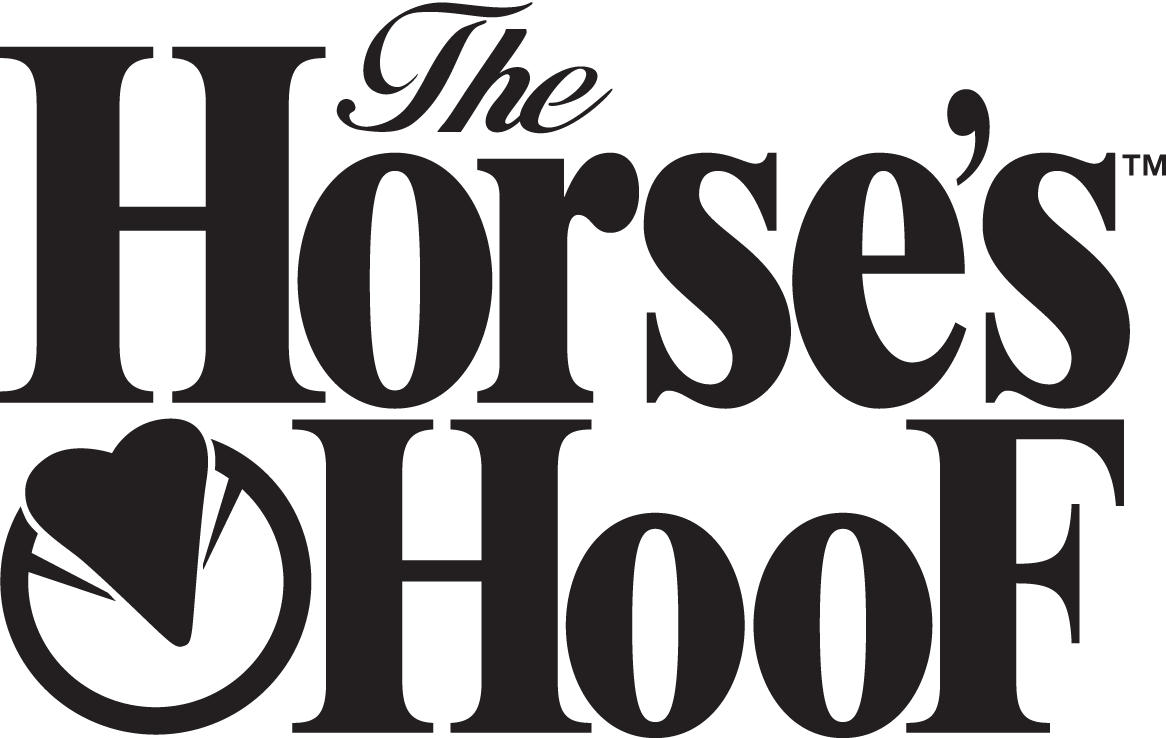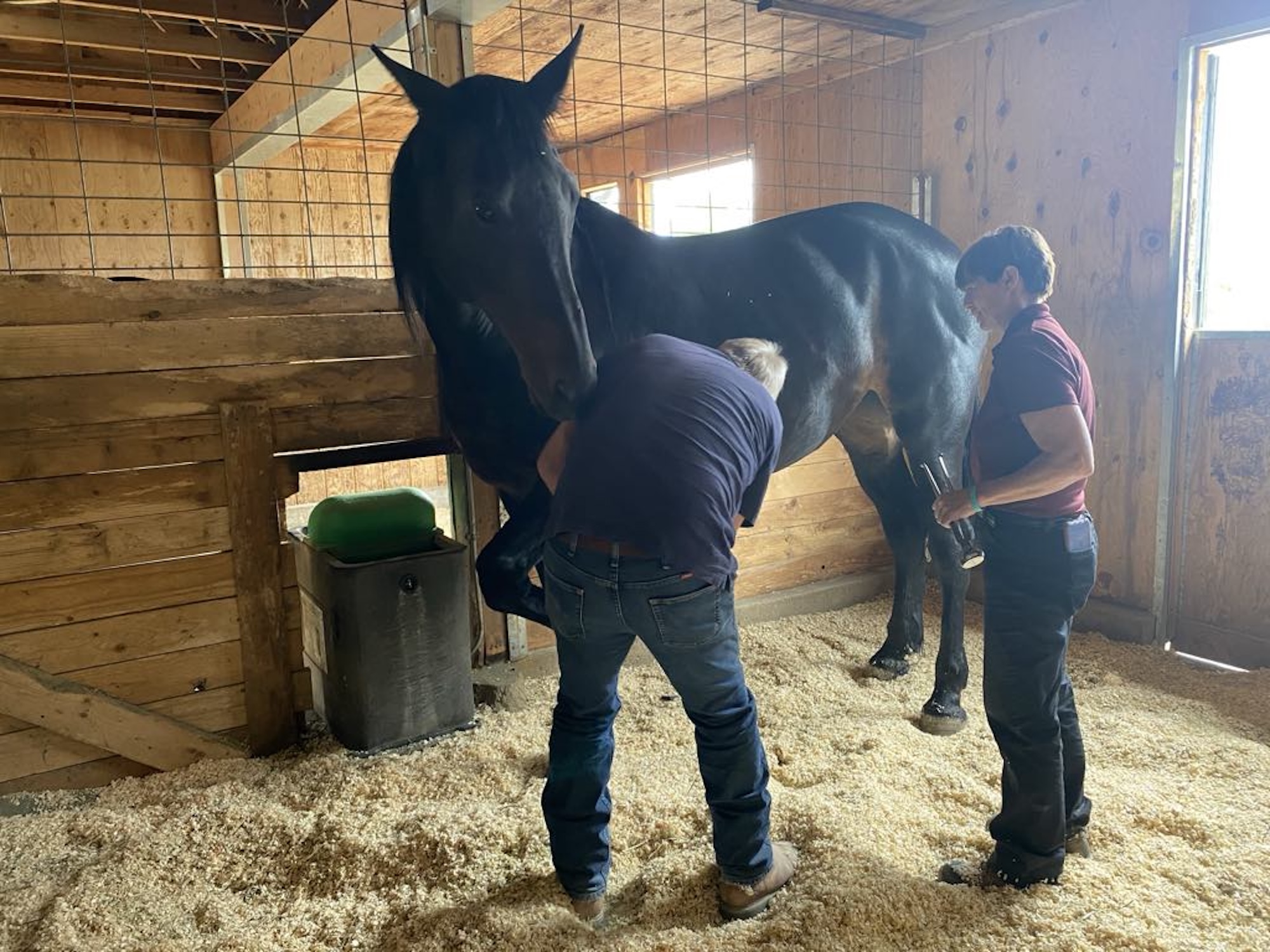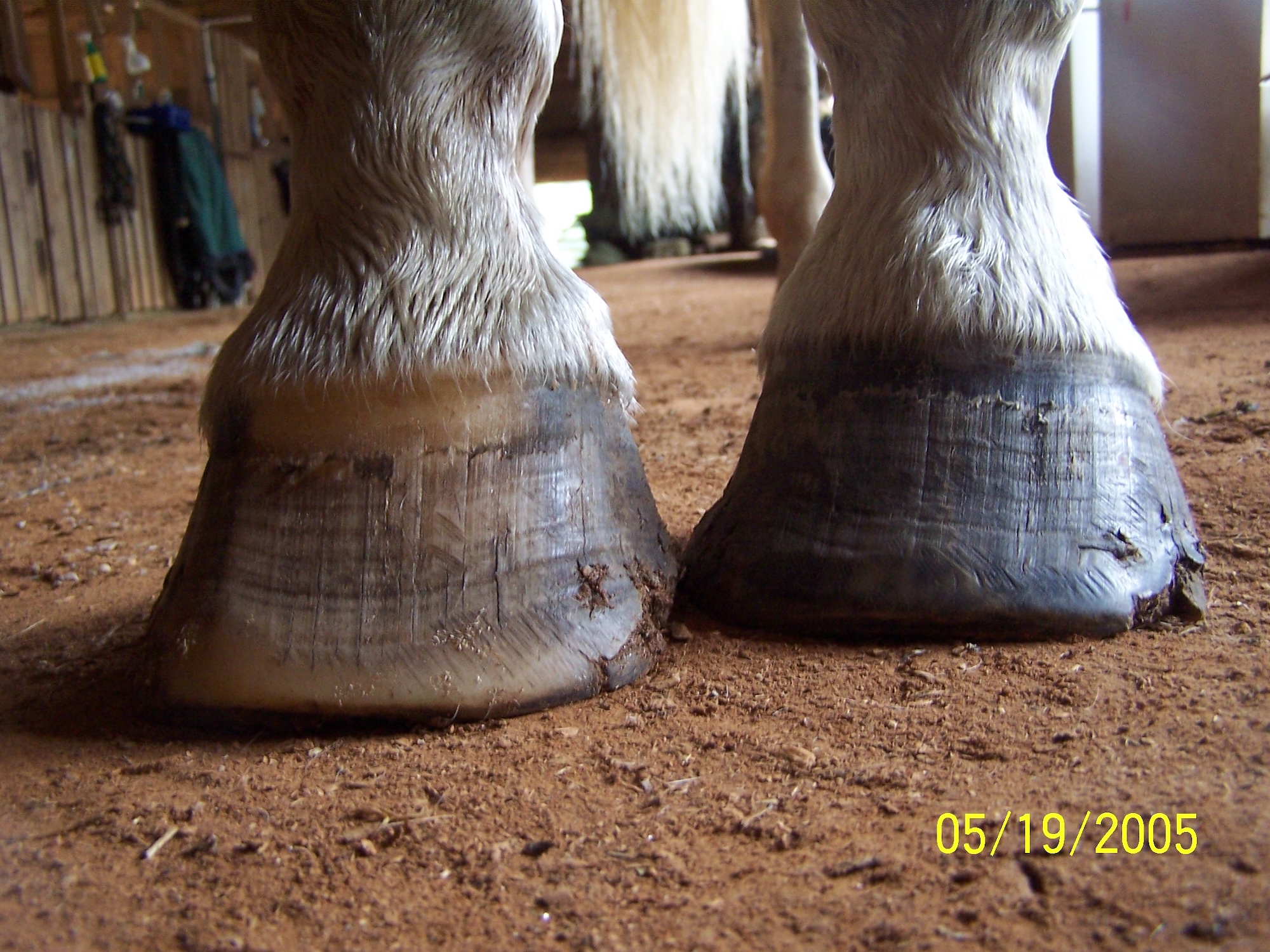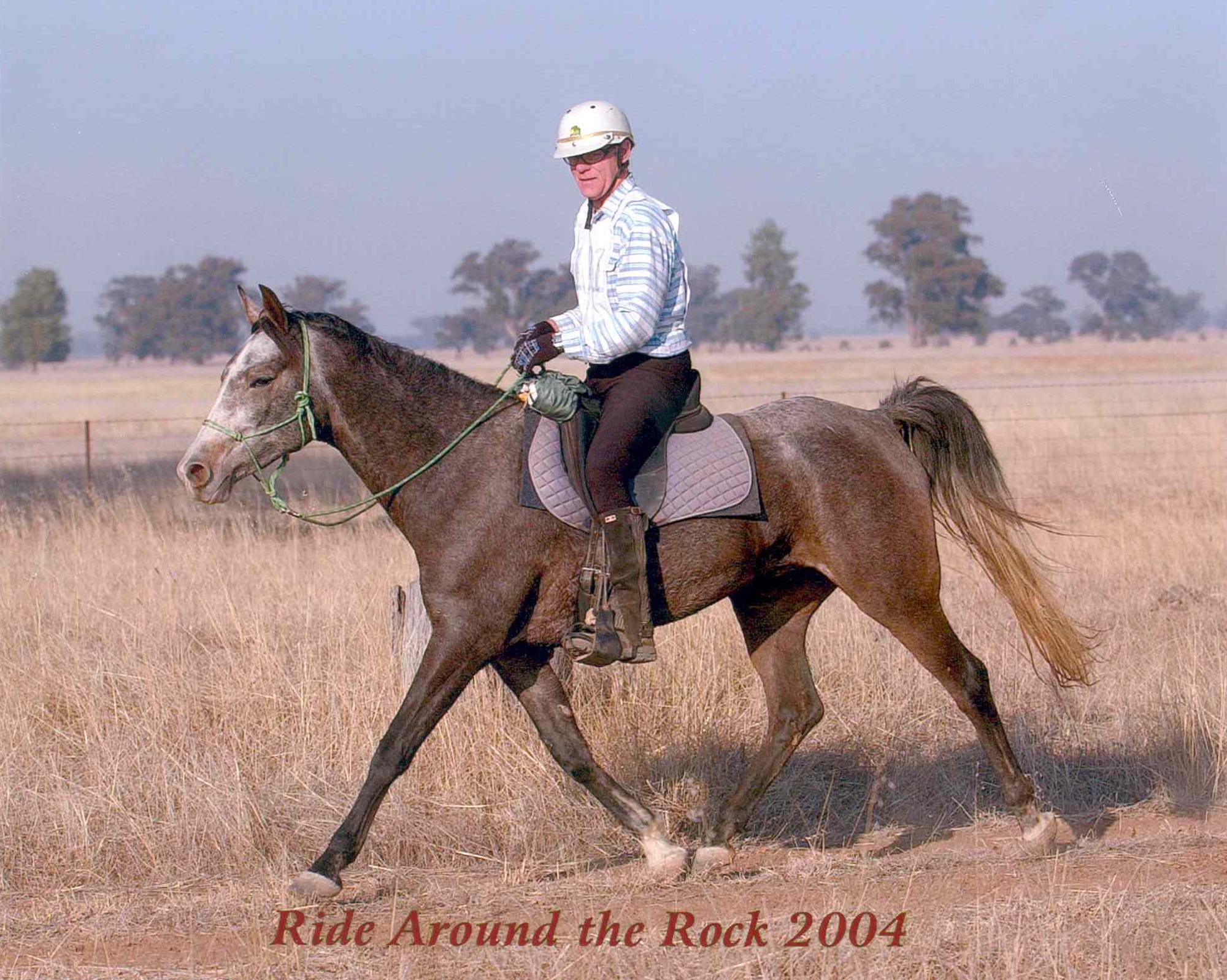This story is about a Friesian named Levi that had 3/4″ lamellar wedges and would only stand maybe 1 or 2 hours a day when I started with him. However, when pea gravel was made available, everything changed – and he was ridden daily for another 5 years. Three vets advised her to put him down but she did everything I asked of her and achieved a different result. It’s all thanks to Dr. Robert Bowker!
I met Levi on July 6th, 2009. He had recently been taken to the veterinarian for radiographs of the front hooves and was diagnosed with incurable founder. Levi’s owner Priscilla was referred to Owl Canyon Hoof Rehab (my trimming business) from another veterinarian and trainer in Cheyenne, WY, so she gave us a call. Immediately we went work recommending:
- Have a blood test done to determine how bad his insulin/glucose ratio was currently at.
- Advised the owner to take him off grain, and start soaking his hay to eliminate the excess carbohydrates in his diet and level off his metabolism.
- Suggested that she provide an area of pea gravel for him to stand in to help support his coffin bones and provide stimulation to promote new sole growth. She filled the barn floor and paddock area with 4″ of small pea gravel.
On the first trim, there was 3/4″ of exposed red ketatinized lamellar wedge showing between the sole and the hoof wall. We followed the founder trim protocol as set forth by studies performed at Auburn University. This involved removing the load bearing forces on the hoof walls and lowering his heels to bring the coffin bone back into proper alignment. This made Levi much more comfortable. The load bearing forces will be kept off the hoof walls until complete reconnection of the dermal laminae of the coffin bone and the epidermal laminae of the hoof wall has been achieved. There are two important reasons for doing this:
1) To place the break over in the correct relationship to the coffin bone, allowing for proper movement of the horse.
2) Without a strong connection of the hoof wall to the coffin bone, the hoof will fail to reattachment to the coffin bone, leaving the hoof wall unable to physically carry any load without further damage.
Once the hoof walls attain reattachment to the coffin bone with healthy laminae, they will then be trimmed to the appropriate length to equally share the load with the sole and frog.
Priscilla started exercising him on a regular basis using Easyboot Epics with 1/2″ thick comfort pads. She started with 20 minute walks and was riding him several miles within a few weeks! The following pictures show the progression of healing. As of January 2010, he was completely sound with only 1/2″ of detached hoof wall left to grow out.
LEVI, BEFORE
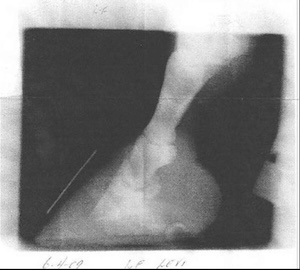

Levi’s First trim:

Below: One month; photos from first trimming of Levi on his new diet. After one month, the angle of the hoof walls are very different.

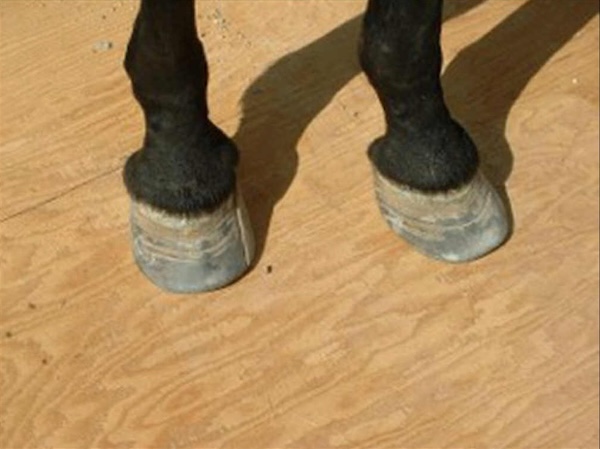
Below, 3rd trim. This shows a shorter toe length and smaller lamelar wedge between the sole and the hoof wall.
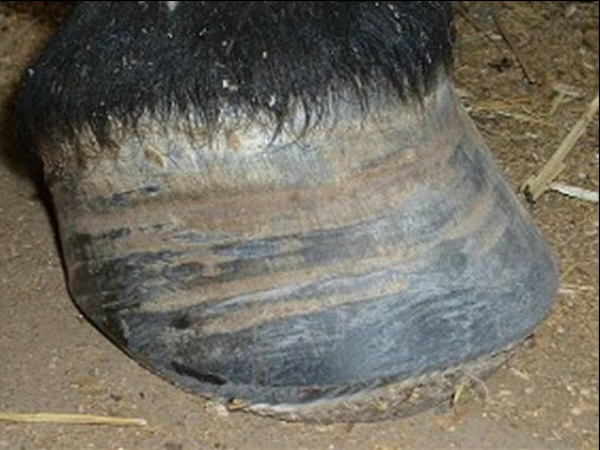
AFTER
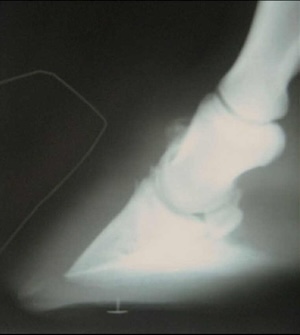
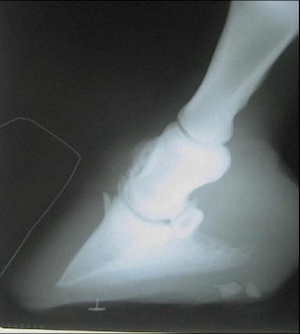
Below, Levi’s hooves in January 2010. The angles are the same because the walls are now attached to the coffin bone.

Below, Levi’s hooves, nearly completely healed in February 2010:

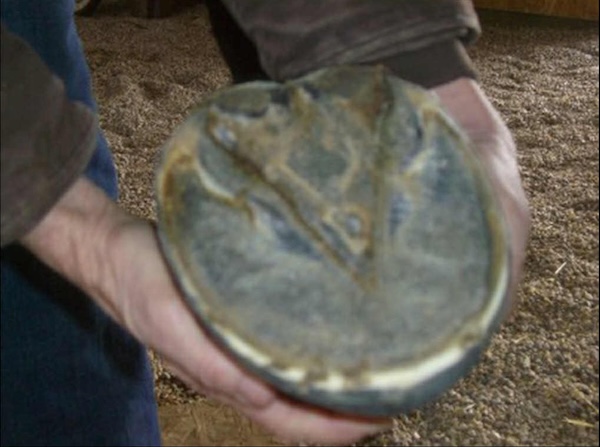
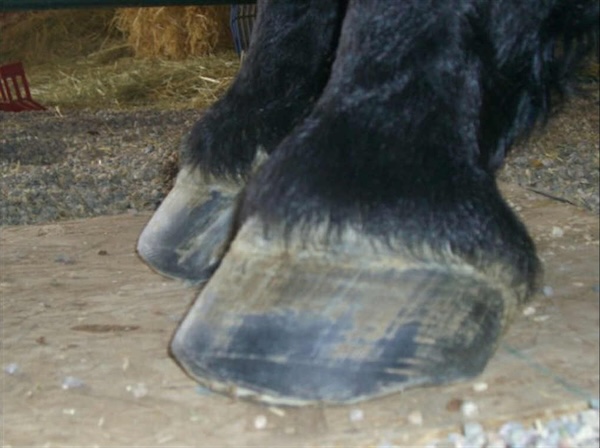
Here’s more details from Levi’s owner:
Levi’s Story by Priscilla Eickstaedt
Here’s my story:
“If He can make a donkey talk, He can make a horse walk”
Levi is a 10 year old Thoroughbred/Friesian, 17 1/2 hands. I have raised him and his mother, a Thoroughbred, from birth. We have been over many miles together mainly going down the roads of Kansas, and some in Wyoming. A horse with a lot of curiosity and willingness. Through the years of riding him there were things that I noticed. He was putting on a bit too much weight. I had three different friends warn me of this. Deryn Stewart, from Ponca City, OK; Ricky Levine, a clinician from CA; and Craig Cameron, a clinician from Texas, that I met in WY – thanks to all of you for the warning.
I noticed that he would urinate all too often, as much as once a mile going down the road. He had a very large fleshy sheath. Then on Jan. 16, 2009, I noticed that he was off on his right front. Not thinking too much about it, I waited for a month, but it didn’t go away. So I took him to the vet on 2-24-09. I had him x-rayed with Vet #1 and he identified arthritis and a small bone broken in the RF. He said that it is a bone that they often see broken in TB’s that stumble out of the gate, but with the type of riding that I do, it should be no problem. He recommended shoeing with Natural Balance shoes and pads, and we will see how he does. This RF foot had a severe barbwire cut when he was a yearling, where he had actually broken the barbwire to get free. He was never x-rayed at the time, but had a cast after a few days and wrapped till it healed. He was lame on it for about a year but finally went sound. In asking the vets what I should be feeding him, they seemed to not be concerned, “he is just an easy keeper.”
The Natural Balance shoes helped very little and by 4-13-09, he was very noticeably lame. At the spring exam, vet #1 looked at the 2-24-09 x-rays and recommended he be injected in the arthritic joint. So Hyolovet 2cc/5 vetalog inj 6mg/ml was put in. For a week he improved, and then he pulled the shoe off, it was replaced immediately, but from there on, he did nothing but go downhill. On 4-24-09, I called Vet #1 to see if re-injecting would be possible. He wanted to wait, thinking that maybe he had just “tweeked something in his foot when he pulled the shoe off.” Levi was getting so that he could hardly stand. He was shifting slowly from one foot to the other. Laying down a lot, to the place that he was down about 75-85% of the time. He was developing sores on his elbows, and hocks. Up only when eating, drinking and going to the bathroom.
At the time that he was injected, I had asked Vet #1 if he thought that I was dealing with laminitis. With his arms crossed he said, “no” – I said, do you think that you should check the other foot? He said, “no.” I asked what I should be feeding him, (he was probably close to 1800#) His helper (assistant) spoke up, “Oh, a round bale a week,” and was never corrected. I asked if it was safe to turn him out to pasture? “Yes.” So I kept up my schedule.
He was laying in the manure pile most of the time, flat out. When putting shoes on him he could hardly stand on one foot to get 2 nails in to hold a shoe in place before he had to put it down to take the pressure off. Nothing was working. He noticeably had more trouble going down hill than up hill. I called vet #1 again on 5-18-09, and he still wanted to wait at least 3 months before re-injecting him. ‘”Go ahead and ride him and it will help the arthritis.” I complained that he just didn’t feel right, and his walk was not normal. He said that “you can bring him in again if you want to.” That was not quite the response that I wanted. I could not stand to make him wait, so I made an appointment for a second opinion.
I had to wait a week for that, and on 6-4-09 I hauled him and his mother for 2 hours to get that second opinion. As we walked him and his mother into the vet’s clinic, his comment was, “it doesn’t look good.” He was just inching his way in on the hard ground. Vet #2 asked if he had been blocked? I said, “no.” So he blocked him in both front feet low, and a little higher. It made him a little more comfortable, but he wanted to x-ray him. He did, finding the arthritis, the little bone broken and rotation in both front feet. Asking me to look at the computer x-rays with him and then turning to me said, “I know how much this horse means to you, but I can give you NO HOPE for him. He is not safe to ride.” and then silence. A real sentence of death. I felt him waiting for me to say, go ahead and put him down. I couldn’t. So I thanked him for his honest opinion, took my horses and loaded them, paid my bill and left. Both vets said that, from the outside looking at the hoof angle, you could not tell there was any problem. So it was a two hour drive home with a horse that I should put down.
But I had read the book by Pete Ramey sometime before on ‘hope for soundness,” and had seen the pictures of horses that were in far worse shape than Levi. I knew that I had to get the weight off the walls, as they were being pulled apart. At that time he weighed approximately 1800#.
So I nipped and rasped a bit on them till I saw some pink, and thought I had better quit. We prayed for wisdom and guidance. Had some of the folks in the church pray. At that time, we took a small animal of ours that was sick to another vet where her walls were full of horse gear. When done, I made the comment, “my husband is taking care of our sick cat, and I am looking after our sick horse with founder.” She told me she had a pony that had been turned around with founder and had come out just fine. She got me in contact with the lady that had helped her, that had heard of a man down in Colorado that was a professional trimmer. After a few phone calls, I was given the name and number of Blaine St Peter from Fort Collins, CO.
I placed two calls to him before he got back to me (a busy man). I told him my “Vet Hopeless” story, and before meeting him, he was telling me how to change his feed from SafeChoice to ADM Staystrong, and how it had minerals in it that were lacking in our area that he needed, and how to soak his hay to get the sugars out if it, and he would be there in a week. He gave me much needed hope.
I impatiently waited for him. I was impressed, a (shoer) trimmer early for an appointment? I showed him the last x-ray from Vet #2. His first trim was on July 6, 2009. He went to work with his nippers, lifting the walls from the quarters, around the front at least 1/2 to 3/4 inches off the ground exposing the pink and the stretched laminae, putting the weight on the sole. He didn’t touch the sole till the third trim. I had 36 stall mats in my center barn and he recommended that I get rid of them, and put 3/8″ washed stone in 4″ deep so Levi could adjust his own comfort zone.
Blaine gave me enough hope that I asked him how long before I would be able to ride him. He said, “about a month.” Exercise was a very important part of the healing process. So I would hand walk him, very reluctantly, and with the encouragement of a little tap of the whip we would walk 1/8 mile and each day just a little further and a little further, till before the month was up, I was climbing up on the gates to get on him bare back and going a little and a little further every day, twice a day. On the first load of gravel as it was still in a pile, he inched his way out and dug his front feet into it, and you saw the relief, and for a moment he gave a little jump for joy and that little spark was finding some hope that there would be relief from the pain he had been living with. I rode him bare back for a while, till I felt more pep in his step.
Blaine was a real “God Send” to us and an answer to prayer.
On the first visit, Blaine recommended that I have him tested for IR (Insulin Resistance). I did and according to the vet’s report, it should be between 4 and 8 and his was 118. We have learned far more than we ever intended to about IR. Before long, I was saddling him and had purchased boots that he wore for a while, and ponying his mom, we were going down the road again. It has been nothing to go up to 10 miles in a ride, he was asking to trot and spook at things for the fun of it, that playful spunk and spark in his eye was back again.
I have noticed a much improved walking stride since Blaine has been trimming him, something that the arthritis was most likely responsible for. By trimming the hoof wall shorter, the sole is allowed to support the inner structure of the foot.
I had Vet #1 re-x-ray him this past January, and according to him, his front feet are in perfect alignment (the coffin bone with the outer wall). After seeing Levi’s progressive hoof trim pictures and seeing him in real life walking into his clinic, Vet #1 said, “it goes against every thing that I have been taught.” He was a shoer himself, to put himself through vet school. I appreciate the vets and all their knowledge, and especially a vet who can acknowledge a real change that has taken place beyond their schooling.
We believe that Blaine St. Peter was a real ‘God Send’ to us and Levi. Thanks a thousand times over.
My thoughts on basic founder protocol:
It is very beneficial in achieving full recovery to make pea gravel available for the horse to stand in as it will distribute the weight of the horse over the whole foot evenly, and to trim back the hoof wall so that it bears very little to no weight during the regrowth of the hoof wall. This also allows for a horse with heels that are already too low to adjust the palmer angle to a comfortable position during regrowth and rehab. It stimulates the sole papillae to grow new sole and keeps the sole exfoliated and dry enough to fight off bacteria and fungus.
I’ve done this many times over the last 20 years with great success no matter what caused the condition in the first place as long as that cause has been addressed.
If the condition was caused by high sugar levels of the feed, switching to a diet of grass hay pellets is very beneficial as the horse can no longer simply soak the carbs off the hay with out fully digesting all of the nutrients available in the hay. Remember when doing this the horse will generally only need 1/2 to 2/3 of the weight that you would normally feed because of the more available nutrients due to the fact that pelleted feed has already been ground fine enough for them to be digested easily.
by Blaine St Peter, The Horse’s Hoof 2025
See the full content listing of all issues of The Horse’s Hoof Magazine! We also provide instructions on how to read the issues for free on Hoof Help Online.
For a detailed listing of all articles on The Horse’s Hoof website, please visit our Article Directory.
